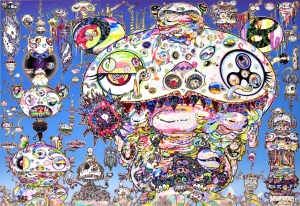
Takashi Murakami
Artist Bio
Takashi Murakami is one of the most visible and important Japanese artists working today. Murakami’s influence on Japan rivals Andy Warhol’s on the United States, and he is known for disseminating and promoting pop art strategies in ways unforeseen by American critics and artists. Unifying many strands of culture that are frequently considered in opposition—traditional Japanese painting with Western influences, the realm of fine art with otaku lifestyle (juvenile culture obsessed with toys, anime, and video games), and commercial retail spaces with museums and other public venues—Murakami’s work is recognized for its ambition, polish, and fine execution.
Murakami’s artistic practice is expansive, spilling into fashion, film, and other commercial areas, but his symbols and interests come from deeper impulses. For instance, Murakami’s use of mushrooms in his work deals with both popular drug cultures and historical concerns. Curator Paul Schimmel, for one, locates the artist’s fascination with mushrooms in a story his mother told him as a child about being born in a city “passed over” by the U.S. atomic bomb. (On the day of the drop, Murakami’s hometown had too much cloud cover and was avoided as a target.) Murakami employs mushrooms in DOB in the Strange Forest (Blue DOB), 1999, in which the artist coyly positions his alter-ego, DOB, in a complex Japanese landscape that is turning to menace. DOB shows resistance, a gesture that clearly indicates Murakami’s critique of culture rather than simply adding to its excesses. It is a powerful statement of how Murakami sees himself in regards to his Japanese culture. He is lost in the runaway madness of its history and decadence.
Social critique is even more pointed in Nurse Ko2 (Original rendering by Nishi-E-Da, modeling by BOME and Genpachi Tokaimura, advised by Masahiko Asano, full scale sculpture by Lucky-Wide Co., Ltd.), 2011. The work addresses bishoujo culture, which is roughly equivalent to “beautiful girl style,” a concept encompassing many features of otaku. Bishoujo is an exaggerated, unrealistic, and fetishized version of the feminine, often based on boys’ fantasies. Murakami’s offering is part cartoon, part naive adolescent wish, part pornography. The conflation of the three mixes into an erotically charged, but silly sculptural resolution. The work is the projection of an overinflated boy mind, which Murakami remarks has contributed to a sterilized and displaced adolescence that hinders Japan.
My arms and legs rot off and though my blood rushes forth, the tranquility of my heart shall be prized above all. (Red blood, black blood, blood that is not blood), 2007, is part of a series of Murakami drawings featuring the portrait of Daruma, the sage, grand patriarch of Zen art and founder of Zen Buddhism. Daruma is famous for sitting in meditation for nine years without blinking, facing the Shaolin monastery. He lost his arms and legs due to severe atrophy, and even today is a symbol fortitude and diligence in Japan. In this work, Daruma is locked in a soft, meditative gaze, heavily mannered in black with bursts of colorful highlights. The painting is quintessential Murakami, mixing the visual devices of pop art with deeper cultural undercurrents. My arms and legs.... is both a view of Japanese history and a critique of the contemporary. Despite the opportunity for sensationalism that the Daruma story opens, Murakami takes a deliberate, sober approach, cropping out gory details and replacing them with the face alone. The emphasis of the work is on meditation, on the slowness of thought, virtues rarely promoted in a hyper-saturated world of instant information. With one foot in that image-saturated world, Murakami steps away from it.
Flower Matango (b), 2001–06, takes pop culture as its starting point. Matango is a 1963 Japanese movie about a group of people stranded on an island of monstrous mushrooms. Murakami imagines his recognizable smiling flowers growing and twisting through the gallery space. Like the mushrooms in Matango, the flowers multiply and take over, a blizzard of pop. For Murakami, popular imagery is an aggressive spore that can neither be contained nor stopped. A version of Flower Matango was exhibited at Versailles in France, its flowers allowed to spiral through Louis XIV’s home in much the same way as the decorative flowers of the rococo overwhelm the wallpaper and ceilings of the palace.












